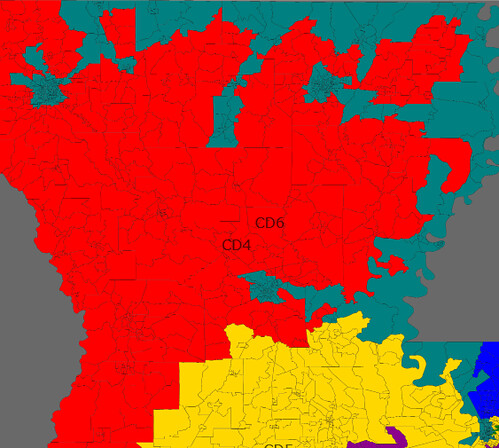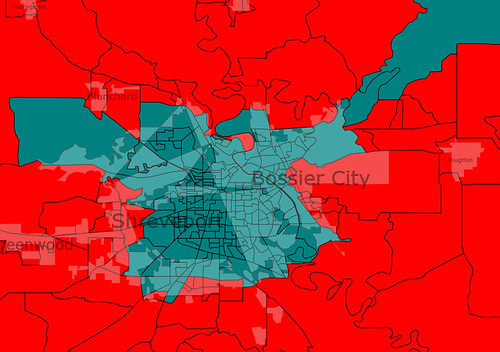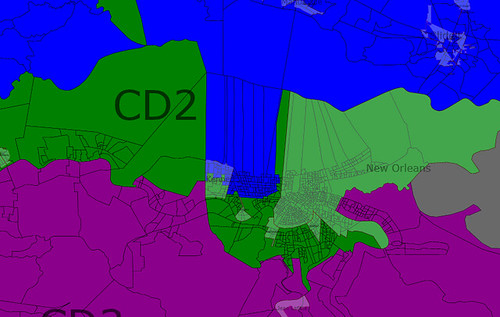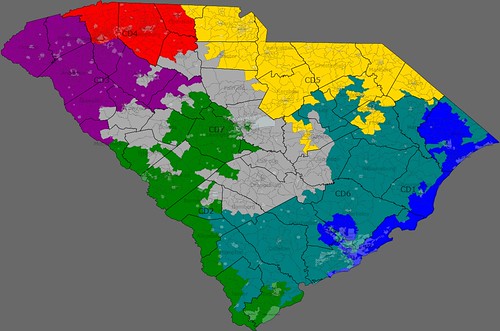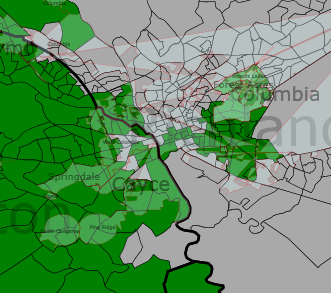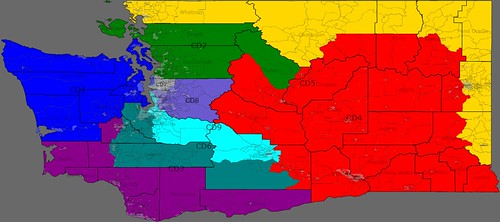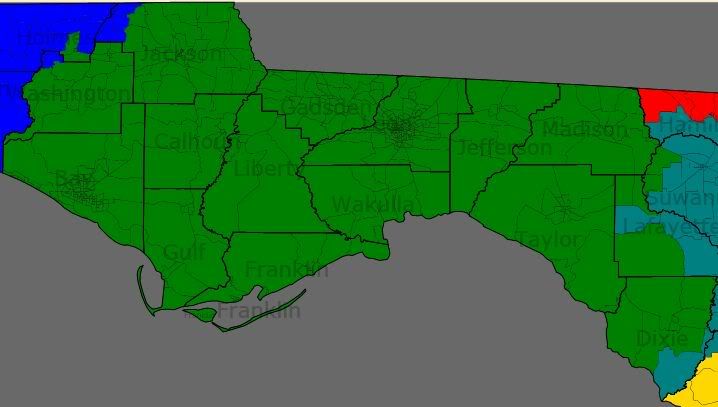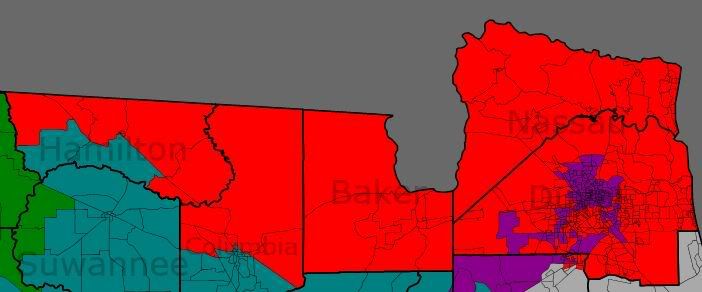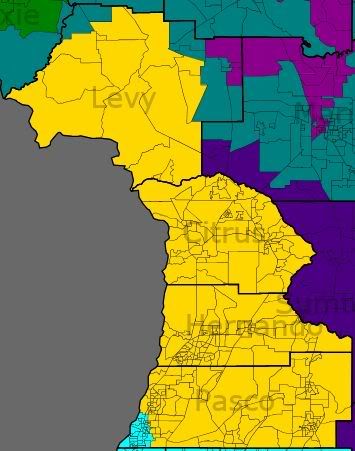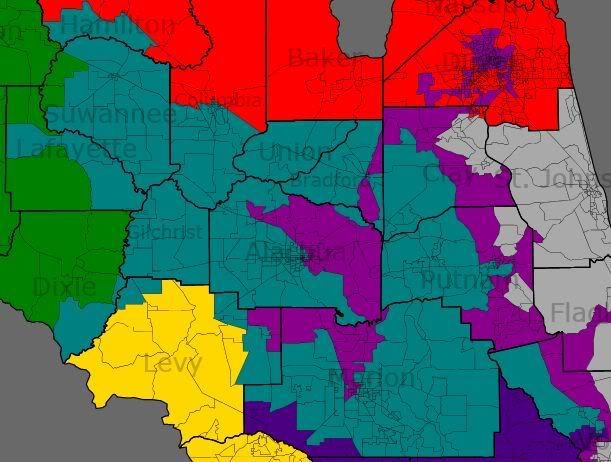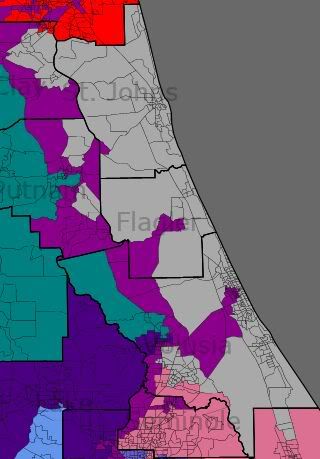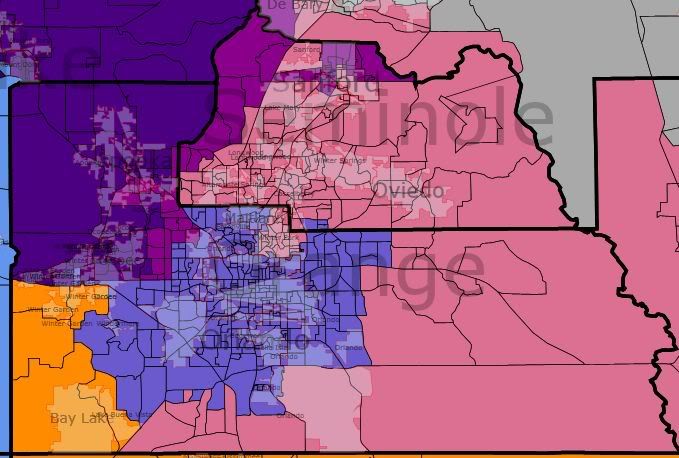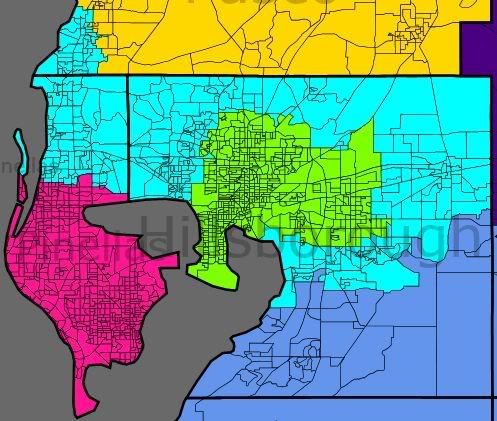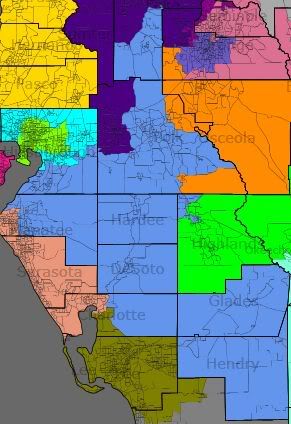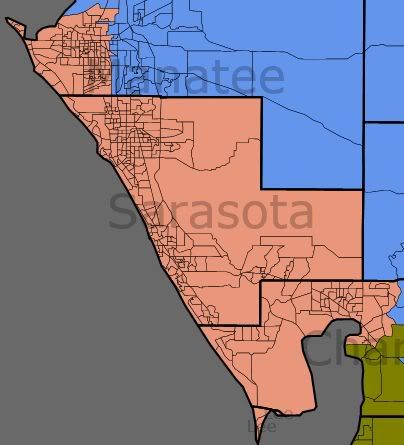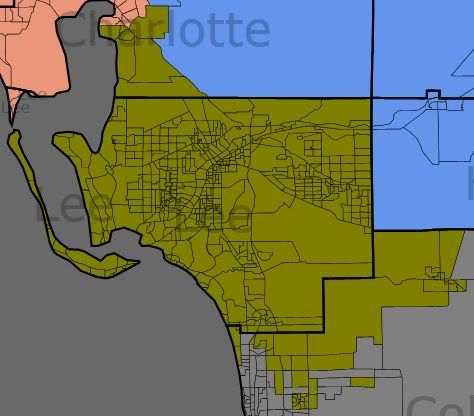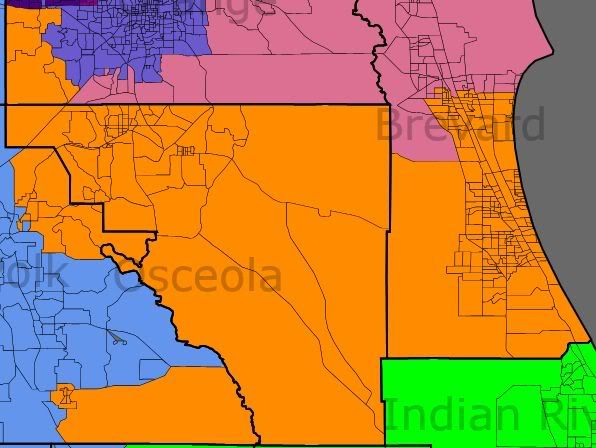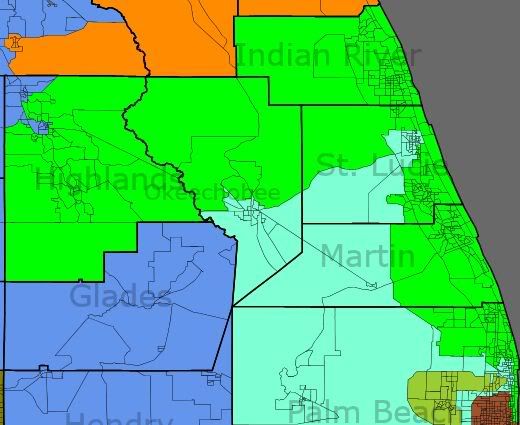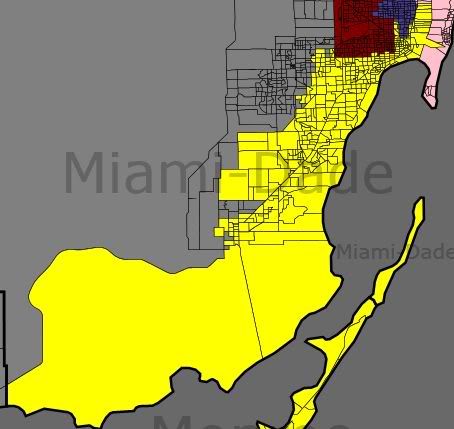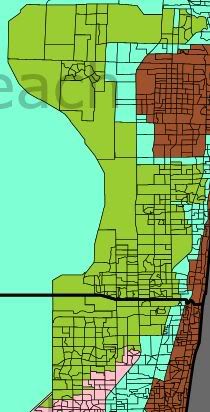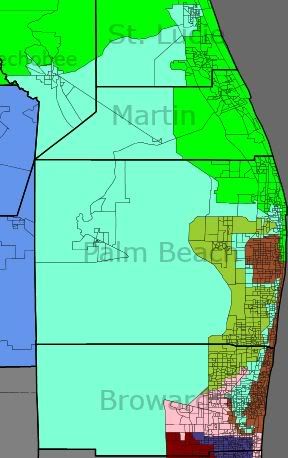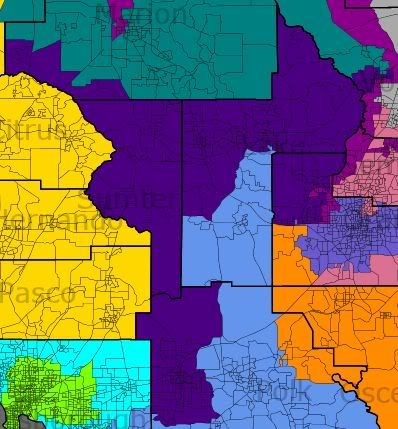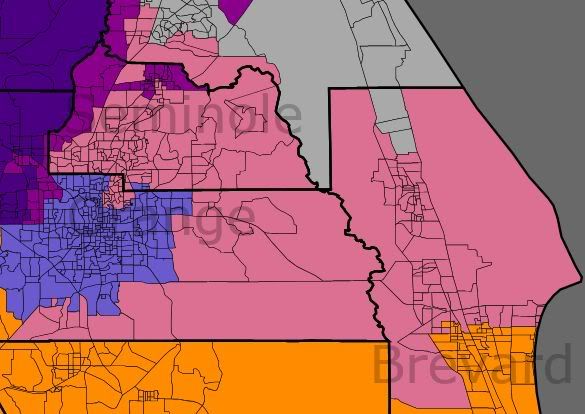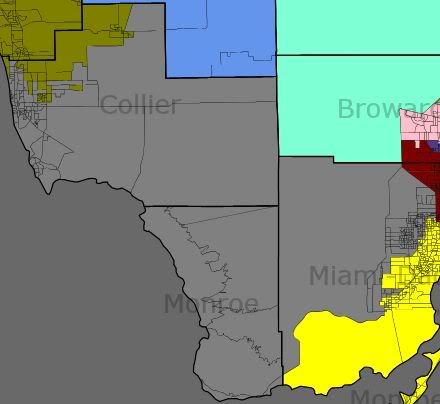Having mapped most of the country in my absurdly low-tech fashion, the release of Dave’s redistricting application (and bandwagon appeal) compels me to revisit some of these states with better data. I’ll start with Florida and Georgia, two states covered by recent diaries but for which my approach is decidedly different.
These maps resemble what I drew on Paint, but not exactly.
Below the fold…
Florida
Like my Paint-generated Florida map, this is based on the assumption of a Republican plan, and more or less consists of incumbent protection with few exceptions (since it does generally protect incumbents, the map wouldn’t be dramatically different if Alex Sink was elected). Re: the Voting Rights Act, I was not able to preserve a black majority in Corrine Brown’s district; 47% was as close as I could seem to get, but with the white population at 40%, other minority groups would seem to make FL-3 VRA-protected.
The new 26th, as in my original iteration, is a modestly GOP-leaning Central Florida seat between the Ocala area and Lake Okeechobee.
The northern half of the state:

The southern half of the state:

Focus on South Florida:

District 1 (blue) – Jeff Miller (R-Chumuckla)
Counties: Escambia, Holmes, Okaloosa, Santa Rosa, Walton
Large minorities: 14% black
Politics: strong Republican
District 2 (dark green) – Allen Boyd (D-Monticello)
Counties: Bay, Calhoun, Dixie, Franklin, Gadsden, Gulf, Jackson, Jefferson, Lafayette, Leon, Liberty, Madison, Taylor, Wakulla, Washington
Large minorities: 25% black
Politics: Republican-leaning when Boyd retires
District 3 (purple) – Corrine Brown (D-Jacksonville)
Counties: Alachua, Clay, Duval, Lake, Orange, Putnam
Large minorities: 47% black (just 40% white)
Politics: strong Democratic
District 4 (red) – Ander Crenshaw (R-Jacksonville)
Counties: Baker, Columbia, Duval, Hamilton, Nassau
Large minorities: 15% black
Politics: strong Republican
District 5 (yellow) – Ginny Brown-Waite (R-Brooksville)
Counties: Citrus, Dixie, Gilchrist, Hernando, Levy, Pasco
Large minorities: none
Politics: strong Republican
District 6 (aquamarine) – Cliff Stearns (R-Ocala)
Counties: Alachua, Baker, Bradford, Clay, Columbia, Hamilton, Marion, Suwannee, Union
Large minorities: 11% black
Politics: strong Republican
District 7 (gray) – John Mica (R-Winter Park)
Counties: Flagler, Lake, Putnam, Seminole, St. Johns, Volusia
Large minorities: 12% Hispanic, 11% black
Politics: generally Republican
District 8 (lavender) – Alan Grayson (D-Orlando)
Counties: Orange
Large minorities: 27% Hispanic, 10% black
Politics: tilting/trending Democratic
District 9 (turquoize) – Gus Bilirakis (R-Palm Harbor)
Counties: Hillsborough, Pasco, Pinellas
Large minorities: 14% Hispanic
Politics: tilting Republican
District 10 (fuchsia) – Bill Young (R-Indian Shores)
Counties: Pinellas
Large minorities: none
Politics: swing/leaning Republican
District 11 (yellow-green) – Kathy Castor (D-Tampa)
Counties: Hillsborough, Pinellas
Large minorities: 28% black, 24% Hispanic
Politics: strong Democratic
District 12 (sky blue) – Adam Putnam (R-Bartow)
Counties: Hardee, Hillsborough, Marion, Polk, Sumter
Large minorities: 15% Hispanic, 12% black
Politics: generally Republican
District 13 (pink) – Vern Buchanan (R-Sarasota)
Counties: DeSoto, Hardee, Manatee, Sarasota
Large minorities: 11% Hispanic
Politics: generally Republican
District 14 (olive) – Connie Mack (R-Fort Myers)
Counties: Charlotte, Collier, Lee
Large minorities: 16% Hispanic
Politics: strong Republican
District 15 (orange) – Bill Posey (R-Rockledge)
Counties: Brevard, Indian River, St. Lucie
Large minorities: 11% black
Politics: generally Republican
District 16 (green) – Tom Rooney (R-Tequesta)
Counties: Charlotte, DeSoto, Glades, Hendry, Highland, Martin, Palm Beach, Okeechobee, St. Lucie
Large minorities: 16% Hispanic
Politics: tilting Republican
District 17 (ash purple) – Kendrick Meek (D-Miami)
Counties: Broward, Miami-Dade
Large minorities: 52% black, 28% Hispanic
Politics: strong Democratic
District 18 (yellow) – Ileana Ros-Lehtinen (R-Miami)
Counties: Miami-Dade, Monroe
Large minorities: 63% Hispanic
Politics: swing/leaning Republican
District 19 (chartreux) – Robert Wexler (D-Boca Raton)
Counties: Broward, Palm Beach
Large minorities: 22% Hispanic
Politics: strong Democratic
District 20 (light pink) – Debbie Wasserman Schultz (D-Weston)
Counties: Broward, Miami-Dade
Large minorities: 31% Hispanic, 11% black
Politics: strong Democratic
District 21 (maroon) – Lincoln Diaz-Balart (R-Miami)
Counties: Miami-Dade
Large minorities: 72% Hispanic
Politics: swing/leaning Republican
District 22 (brown) – Ron Klein (D-Boca Raton)
Counties: Broward, Palm Beach
Large minorities: 15% Hispanic
Politics: tilting Democratic
District 23 (mint green) – Alcee Hastings (D-Miramar)
Counties: Broward, Palm Beach
Large minorities: 52% black, 18% Hispanic
Politics: strong Democratic
District 24 (violet) – Suzanne Kosmas (D-New Smyrna Beach)
Counties: Brevard, Flagler, Orange, Seminole, Volusia
Large minorities: 13% Hispanic
Politics: swing
District 25 (salmon) – Mario Diaz-Balart (R-Miami)
Counties: Collier, Miami-Dade, Monroe
Large minorities: 65% Hispanic
Politics: swing/leaning Republican
District 26 (charcoal) – New
Counties: Highland, Lake, Marion, Okeechobee, Osceola, Polk
Large minorities: 25% Hispanic
Politics: tilting Republican
Georgia
While it’s possible Roy Barnes or another Democrat will win the open governor’s mansion (a possibility in Florida too), I’m tentatively betting on a GOP gerrymander that finally cracks Jim Marshall’s district and makes the districts of Sanford Bishop and John Barrow majority-minority at last (Bishop’s would have an outright black majority, Barrow’s being 48% black and 46% white).
The most controversial choice I made was to kill those two birds with one stone by dividing Marshall’s Macon base, giving most of urban Macon (which is heavily black) to Bishop (thereby forcing Marshall against the more entrenched Bishop in a majority-black district based in Southwest Georgia that Bishop would be clearly favored to win) and rendering the 8th even more rural and white.
I kept all three black-majority Atlanta districts over 50%, did my best to protect GOP incumbents in the suburbs, and created a new GOP-leaning suburban seat. In short, the quintessential Republican map. The only part I may have seriously screwed up was Linder’s district…it’s getting harder and harder to keep his portion of Gwinnett County solidly in GOP hands, and the 7th is now the most diverse district in the state.


District 1 (blue) – Jack Kingston (R-Savannah)
Description: entire coastline, rural South Georgia, white areas of Savannah, Valdosta, Vidalia
VRA stats: 72% white, 21% black
Politics: strong Republican
District 2 (dark green) – Sanford Bishop (D-Albany) vs. Jim Marshall (D-Macon) [Bishop would likely win primary in mostly intact but newly black-majority district despite Marshall’s Macon base)
Description: rural Southwest Georgia, Columbus, Albany, most of Macon and Valdosta
VRA stats: 52% black, 42% white
Politics: generally Democratic
District 3 (purple) – Lynn Westmoreland (R-Grantville)
Description: Atlanta exurbs to the south
VRA stats: 68% white, 25% black
Politics: strong Republican
District 4 (red) – Hank Johnson (D-Lithonia)
Description: most of DeKalb County
VRA stats: 51% black, 32% white, 11% Hispanic
Politics: strong Democratic
District 5 (yellow) – John Lewis (D-Atlanta)
Description: heart of Atlanta, remainder of DeKalb County
VRA stats: 54% black, 34% white
Politics: strong Democratic
District 6 (aquamarine) – Tom Price (R-Roswell)
Description: north Atlanta suburbs — Cherokee County, portions of Bartow and Cobb, north Fulton
VRA stats: 78% white
Politics: strong Republican
District 7 (gray) – John Linder (R-Duluth)
Description: most of Gwinnett County, small portion of Forsyth
VRA stats: 47% white, 22% black, 18% Hispanic, 11% Asian [most diverse, and rapidly diversifying, district in the state; this could be serious trouble for the Republicans by the mid-to-late 2010s]
Politics: tilting Republican but trending Democratic
District 8 (lavender) – open/not Jim Marshall
Description: far southern outskirts of Atlanta MSA, Warner Robins, rural Middle Georgia, down to Thomasville and Quitman
VRA stats: 66% white, 27% black
Politics: fairly strong Republican
District 9 (turquoise) – Nathan Deal (R-Gainesville)
Description: Appalachian North Georgia, Dalton, Gainesville, far north exurban Atlanta
VRA stats: 80% white, 13% Hispanic
Politics: strong Republican
District 10 (fuchsia) – Paul Broun (R-Athens)
Description: Northeast Georgia, Athens, north and west Augusta
VRA stats: 77% white, 15% black
Politics: strong Republican
District 11 (yellow-green) – Phil Gingrey (R-Marietta)
Description: northwest Atlanta suburbs/exurbs, much of Cobb County
VRA stats: 67% white, 19% black
Politics: strong Republican
District 12 (sky blue) – John Barrow (D-Savannah)
Description: southeast Augusta, northwest Savannah, rural eastern Georgia [meant to concentrate black population]
VRA stats: 48% black, 46% white [not quite a majority but closer than before]
Politics: generally Democratic
District 13 (pink) – David Scott (D-Atlanta)
Description: south Fulton County, all of Clayton and Douglas, southeast Cobb
VRA stats: 52% black, 33% white, 10% Hispanic
Politics: strong Democratic
District 14 (olive) – New
Description: east Atlanta suburbs/exurbs — most of Forsyth County, remainders of Gwinnett and Hall, stretching south through Barrow, Walton, Rockdale, Newton, and Butts
VRA stats: 71% white, 18% black [I should definitely have weakened Republican strength here for Linder’s benefit…live and learn, I guess!]
Politics: strong Republican [again, split the difference between this and the 7th and you have two fairly strong GOP districts]
So there you are, computer-generated equivalents of two of my maps. I’ve also done Texas and Missouri on Dave’s app and will post those at a later date.









